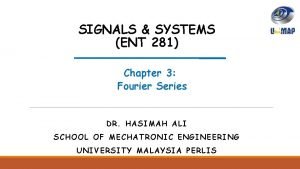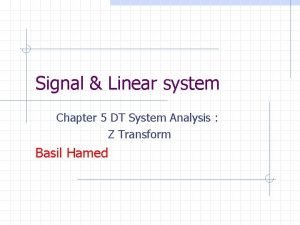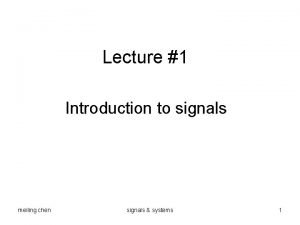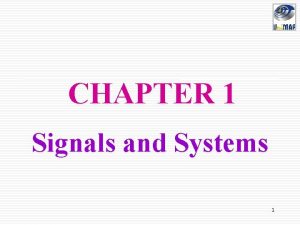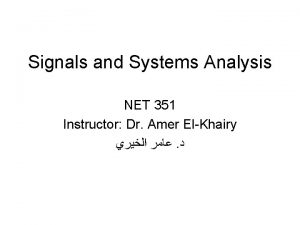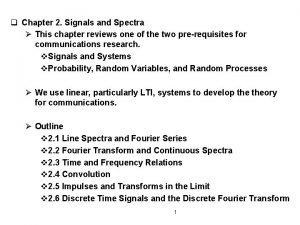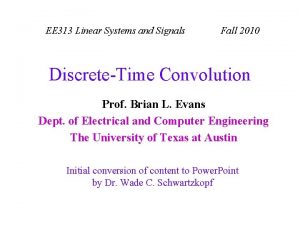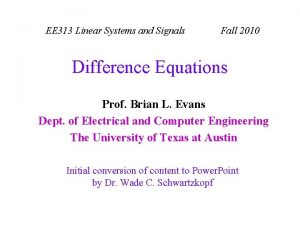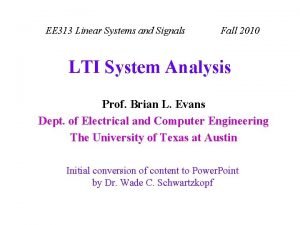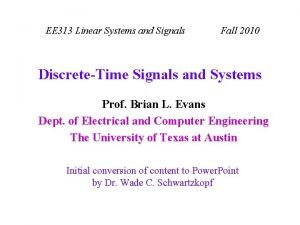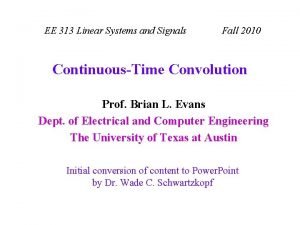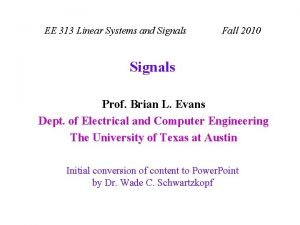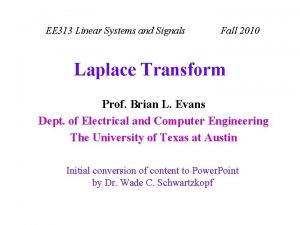EE 313 Linear Systems and Signals Fall 2010








- Slides: 8

EE 313 Linear Systems and Signals Fall 2010 Fourier Series Prof. Brian L. Evans Dept. of Electrical and Computer Engineering The University of Texas at Austin Initial conversion of content to Power. Point by Dr. Wade C. Schwartzkopf

Course Outline • Time domain analysis (lectures 1 -10) Roberts, ch. 1 -3 Signals and systems in continuous and discrete time Convolution: finding system response in time domain • Frequency domain analysis (lectures 11 -16) Fourier series Fourier transforms Frequency responses of systems Roberts, ch. 4 -7 • Generalized frequency domain analysis (lectures 17 -26) Laplace and z transforms of signals Roberts, ch. 9 -12 Tests for system stability Transfer functions of linear time-invariant systems 2

Periodic Signals • For some positive constant T 0 f(t) is periodic if f(t) = f(t + T 0) for all values of t (- , ) Smallest value of T 0 is the period of f(t) • A periodic signal f(t) Unchanged when time-shifted by one period May be generated by periodically extending one period Area under f(t) over any interval of duration equal to the period is same; e. g. , integrating from 0 to T 0 would give the 3 same value as integrating from –T 0/2 to T 0 /2

Sinusoids • Fundamental f 1(t) = C 1 cos(2 p f 0 t + q 1) Fundamental frequency in Hertz is f 0 Fundamental frequency in rad/s is w 0 = 2 p f 0 • Harmonic fn(t) = Cn cos(2 p n f 0 t + qn) Frequency, n f 0, is nth harmonic of f 0 • Magnitude/phase and Cartesian representations Cn cos(n w 0 t + qn) = Cn cos(qn) cos(n w 0 t) - Cn sin(qn) sin(n w 0 t) = an cos(n w 0 t) + bn sin(n w 0 t) 4

Fourier Series • General representation of a periodic signal • Fourier series coefficients • Compact Fourier series 5

Existence of the Fourier Series • Existence • Convergence for all t • Finite number of maxima and minima in one period of f(t) • What about periodic extensions of 6

Example #1 f(t) A -1 0 -A 1 • Fundamental period T 0 = 2 • Fundamental frequency f 0 = 1/T 0 = 1/2 Hz w 0 = 2 p/T 0 = p rad/s 7

Example #2 f(t) 1 -2 p -p -p/2 p 2 p • Fundamental period T 0 = 2 p • Fundamental frequency f 0 = 1/T 0 = 1/(2 p) Hz w 0 = 2 p/T 0 = 1 rad/s 8
 Animals and human language chapter 2
Animals and human language chapter 2 Informative signals example
Informative signals example Communicative signals and informative signals
Communicative signals and informative signals Exponential fourier series coefficients
Exponential fourier series coefficients Signals and systems oppenheim solutions chapter 5
Signals and systems oppenheim solutions chapter 5 Precedence rule in signals and systems
Precedence rule in signals and systems Precedence rule in signals and systems
Precedence rule in signals and systems Convolution sum in signals and systems
Convolution sum in signals and systems Rayleigh energy theorem
Rayleigh energy theorem



